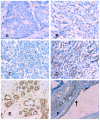Loss of Dab2 expression in breast cancer cells impairs their ability to deplete TGF-β and induce Tregs development via TGF-β
- PMID: 24638085
- PMCID: PMC3956763
- DOI: 10.1371/journal.pone.0091709
Loss of Dab2 expression in breast cancer cells impairs their ability to deplete TGF-β and induce Tregs development via TGF-β
Abstract
Dab2 is a multifunctional adapter protein which is frequently under-expressed in a variety of cancers. It is implicated in many critical functions, including several signaling pathways, cell arrangement, differentiation of stem cells, and receptor endocytosis. Transforming growth factor-β (TGF-β) is a secreted multifunctional protein that controls several developmental processes and pathogenesis of many diseases. It has been documented that Dab2 played an important role in TGF-β receptors endocytosis. Here, we present evidence that re-expression of Dab2 in SK-BR-3 cell partially restored its ability to deplete TGF-β in surrounding medium by normalizing the trafficking of TGF-β receptors. We also demonstrate that the difference in TGF-β depletions produced by Dab2 expression was sufficient to impact on the conversion of naive CD4+ T cells to regulatory T cells (Tregs), and thus inhibited the proliferation of T cells. This work revealed a critical result that breast cancer cell was deficient in Dab2 expression and related receptor endocytosis-mediated TGF-β depletion, which may contribute to the accumulation of TGF-β in tumor microenvironment and the induction of immune tolerance.
Conflict of interest statement
Figures









Similar articles
-
Disable 2, A Versatile Tissue Matrix Multifunctional Scaffold Protein with Multifaceted Signaling: Unveiling Role in Breast Cancer for Therapeutic Revolution.Cell Biochem Biophys. 2024 Jun;82(2):501-520. doi: 10.1007/s12013-024-01261-5. Epub 2024 Apr 9. Cell Biochem Biophys. 2024. Retraction in: Cell Biochem Biophys. 2025 Mar 17. doi: 10.1007/s12013-025-01715-4. PMID: 38594547 Retracted. Review.
-
Dab2 inhibits the cholesterol-dependent activation of JNK by TGF-β.Mol Biol Cell. 2014 May;25(10):1620-8. doi: 10.1091/mbc.E13-09-0537. Epub 2014 Mar 19. Mol Biol Cell. 2014. PMID: 24648493 Free PMC article.
-
MicroRNA-106b is involved in transforming growth factor β1-induced cell migration by targeting disabled homolog 2 in cervical carcinoma.J Exp Clin Cancer Res. 2016 Jan 15;35:11. doi: 10.1186/s13046-016-0290-6. J Exp Clin Cancer Res. 2016. PMID: 26769181 Free PMC article.
-
Cathepsin-B-mediated cleavage of Disabled-2 regulates TGF-β-induced autophagy.Nat Cell Biol. 2016 Aug;18(8):851-63. doi: 10.1038/ncb3388. Epub 2016 Jul 11. Nat Cell Biol. 2016. PMID: 27398911 Free PMC article.
-
Emerging Roles of Disabled Homolog 2 (DAB2) in Immune Regulation.Front Immunol. 2020 Oct 15;11:580302. doi: 10.3389/fimmu.2020.580302. eCollection 2020. Front Immunol. 2020. PMID: 33178208 Free PMC article. Review.
Cited by
-
Identification and Validation of a Prognostic Signature Based on Methylation Profiles and Methylation-Driven Gene DAB2 as a Prognostic Biomarker in Differentiated Thyroid Carcinoma.Dis Markers. 2022 Sep 17;2022:1686316. doi: 10.1155/2022/1686316. eCollection 2022. Dis Markers. 2022. PMID: 37223105 Free PMC article.
-
Disable 2, A Versatile Tissue Matrix Multifunctional Scaffold Protein with Multifaceted Signaling: Unveiling Role in Breast Cancer for Therapeutic Revolution.Cell Biochem Biophys. 2024 Jun;82(2):501-520. doi: 10.1007/s12013-024-01261-5. Epub 2024 Apr 9. Cell Biochem Biophys. 2024. Retraction in: Cell Biochem Biophys. 2025 Mar 17. doi: 10.1007/s12013-025-01715-4. PMID: 38594547 Retracted. Review.
-
Integrin traffic - the update.J Cell Sci. 2015 Mar 1;128(5):839-52. doi: 10.1242/jcs.161653. Epub 2015 Feb 6. J Cell Sci. 2015. PMID: 25663697 Free PMC article. Review.
-
Dab2, a negative regulator of DC immunogenicity, is an attractive molecular target for DC-based immunotherapy.Oncoimmunology. 2015 Feb 3;4(1):e984550. doi: 10.4161/2162402X.2014.984550. eCollection 2015 Jan. Oncoimmunology. 2015. PMID: 25949867 Free PMC article.
-
miR-106b targets DAB2 to promote hepatocellular carcinoma cell proliferation and metastasis.Oncol Lett. 2018 Sep;16(3):3063-3069. doi: 10.3892/ol.2018.8970. Epub 2018 Jun 15. Oncol Lett. 2018. PMID: 30127897 Free PMC article.
References
-
- Jemal A, Bray F (2011) Center MM, Ferlay J, Ward E, et al (2011) Global cancer statistics. CA Cancer J Clin 61: 69–90. - PubMed
-
- Sheng Z, He J, Tuppen JA, Sun W, Fazili Z, et al. (2000) Structure, sequence, and promoter analysis of human disabled-2 gene (DAB2). Genomics 70: 381–386. - PubMed
-
- Zhou J, Hsieh JT (2001) The inhibitory role of DOC-2/DAB2 in growth factor receptor-mediated signal cascade. DOC-2/DAB2-mediated inhibition of ERK phosphorylation via binding to Grb2. J Biol Chem 276: 27793–27798. - PubMed
MeSH terms
Substances
LinkOut - more resources
Full Text Sources
Other Literature Sources
Medical
Research Materials

